Can you visit the incredible cities of Alcobaca, Batalha, and Tomar in one day? Yes! We show you how to do it as a day trip from Lisbon Portugal
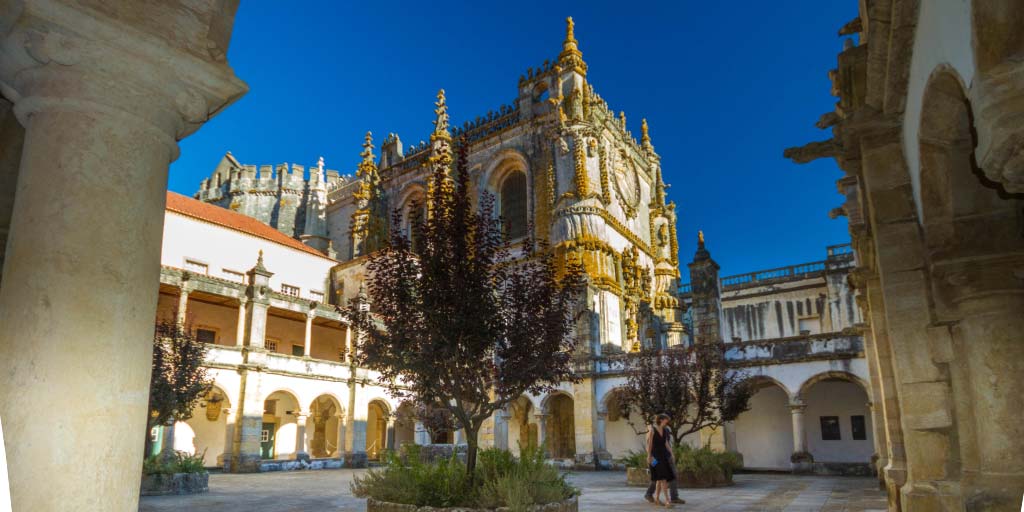
Portugal is ripe with history. This country, which birthed some of the world’s greatest explorers. Yet, nestled within this beautiful nation is where the true heart of Portugal lies. With over 80% of Portugal identifying as Catholic, there is no lack of important religious sites in Portugal. So, during our travels in Portugal, we made sure to take in some of the country’s most spectacular religious sites like Alcobaca, Batalha, and Tomar.
There was something magical about exploring the rich history of Portugal’s monasteries in Alcobaca, Batalha, and Tomar. Walking through incredible architecture was like stepping through a portal and into the rich history of Portugal during it’s most ambitious days. And what’s great about these sites is that it’s possible to visit Alcobaca, Batalha, and Tomar in one day on a day trip from Lisbon! And if you don’t want to drive yourself, you can join an organized tour from Lisbon that explores these three incredible sites.
Alcobaca, Batalha, and Tomar: The Great Monasteries of Portugal’s Heartland
In the heart of Portugal, north of Lisbon lies the Estremadura and Ribatejo regions of Portugal. The area is known for its historical villages, fertile farmland and of course, some of Portugal’s legendary castles! We had so much to see in the region, including a separate day trip to Evora, Portugal.
But, with only a limited time in the country, we decided to head to the region to visit 3 highly accessible UNESCO World Heritage Sites, Alcobaca Monastery, Batalha Monastery, and the Convent of Christ in Tomar. And, even with a baby in tow, exploring the cloisters, heritage, and amazing churches of Alcobaca, Batalha, and Tomar was an amazing adventure.
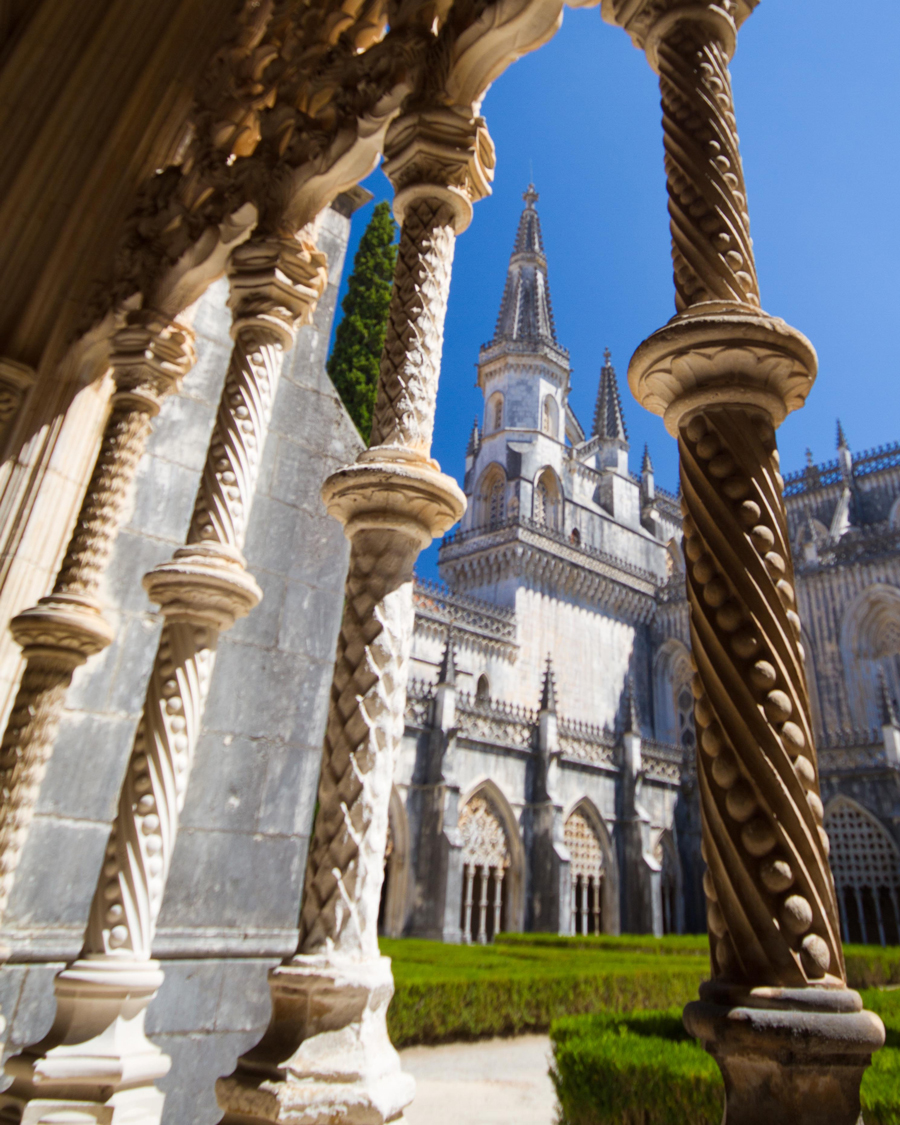
How To Get To From Lisbon To Alcobaca, Batalha, and Tomar?
Visiting the three monasteries of the Estramadura region is an easy day trip from Lisbon. It’s about a 1.5-hour drive from Lisbon to Alcobaca. Once you are there, the three cities of Alcobaca, Batalha, and Tomar are just 65 km (40 miles) from each other with Tomar being the farthest from Lisbon.
Visiting Alcobaca Monastery in Alcobaca Portugal
Alcobca Portugal is just 100 km north of Lisbon. The prime reason for our visit was to ogle the magnificent gothic monastery of Alcobaca. This gorgeous complex is often referred to as the Alcobaca Monastery, but its official name is Mosteiro de Santa Maria de Alcobaca.
Alcobaca Portugal is not a big town, so it’s very easy to navigate the region on foot. We drove to the town and parked our car near the central square. Surprisingly, for such a popular attraction in Portugal, finding parking wasn’t too difficult.
The Alcobaca church and monastery was commissioned by King Afonso, the first king of Portugal, in 1138 AD to commemorate his victory of Santarem from Moorish control. The structure was finally completed in 1223 AD.
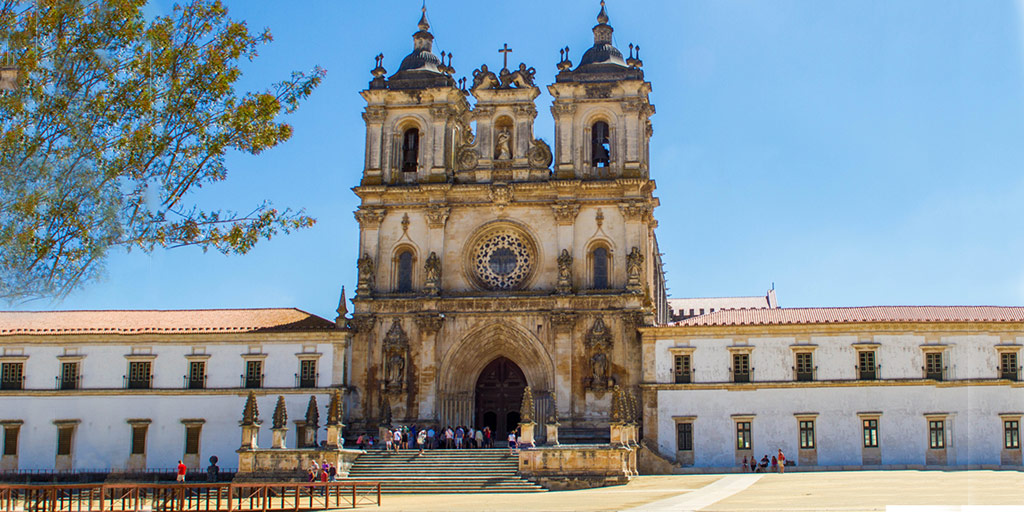
Pro-Tip: For those that do not want to drive or rent a car, it is possible to get to Alcobaca from Lisbon bus.
During the 17th and 18th centuries, the original Gothic facade was altered such that only the doorway and rose window were part of the original concept. Additionally, at this time, wings were added. Today it holds a UNESCO World Heritage Site designation and is Portugal’s largest Gothic church.
Inside the Alcobaca Church
There was no entrance fee for entering the Alcobaca church when we visited. As we merged with the crowds entering the church through the massive archway, the first thing I noticed was the very large pillars that lined the nave. At 106 m in length and 23 m in width, it is almost impossible to comprehend it’s size without actually walking it.
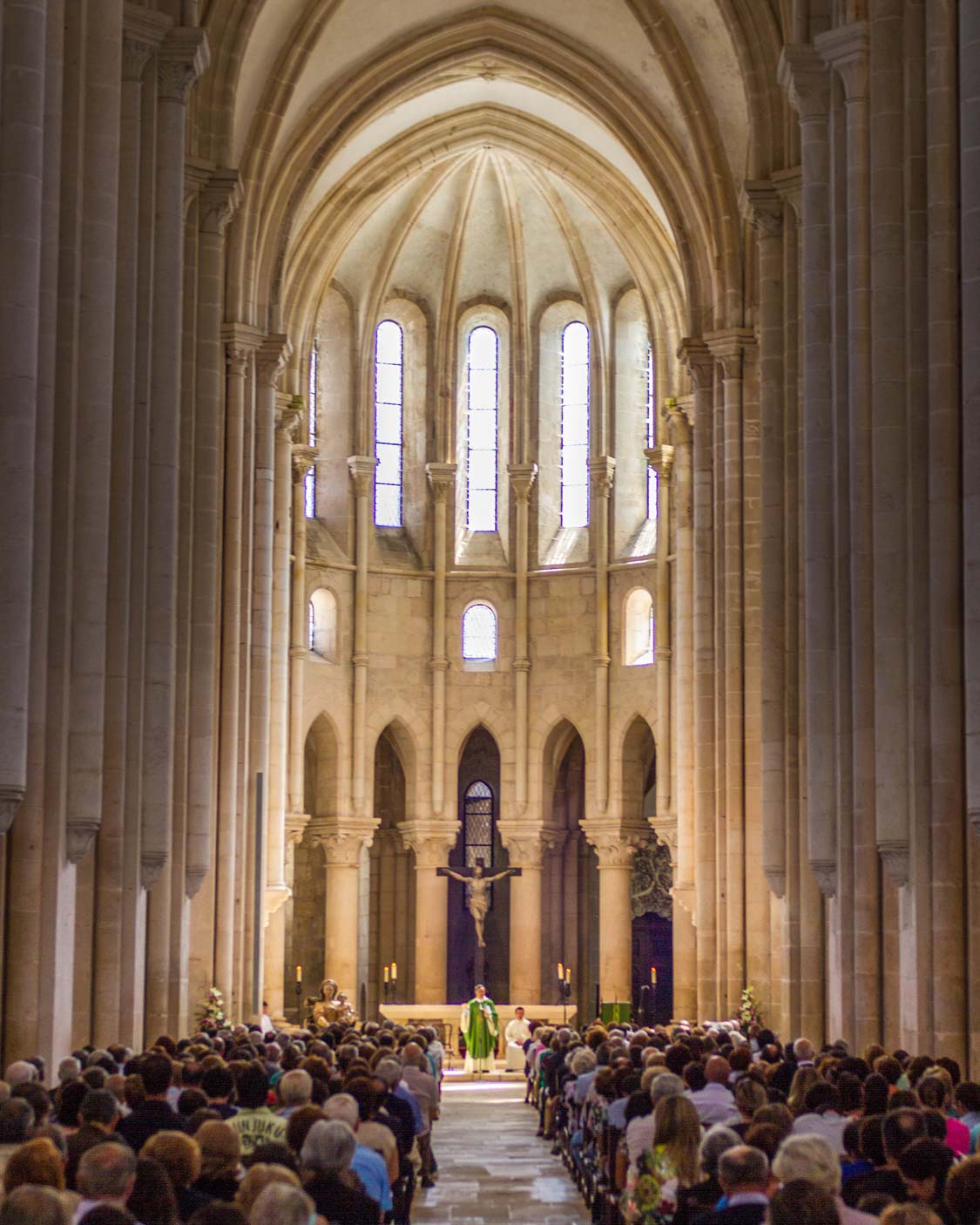
The Love Story Of Dom Pedro and Dona Ines
We headed further towards the back of the Alcobaca church and then I saw it. The Tombs of Dom Pedro and Dona Ines laying foot to foot. The love story of Dom Pedro and Dona Ines is a tragic one. They were lovers who married in secret. Dom Pedro’s father, who was the ruling king at the time, thought that Ines would not be a good choice politically and forbade the lovers’ relationship. In fact, he was so worried about their potential union and its effects on the crown, that he had her assassinated.
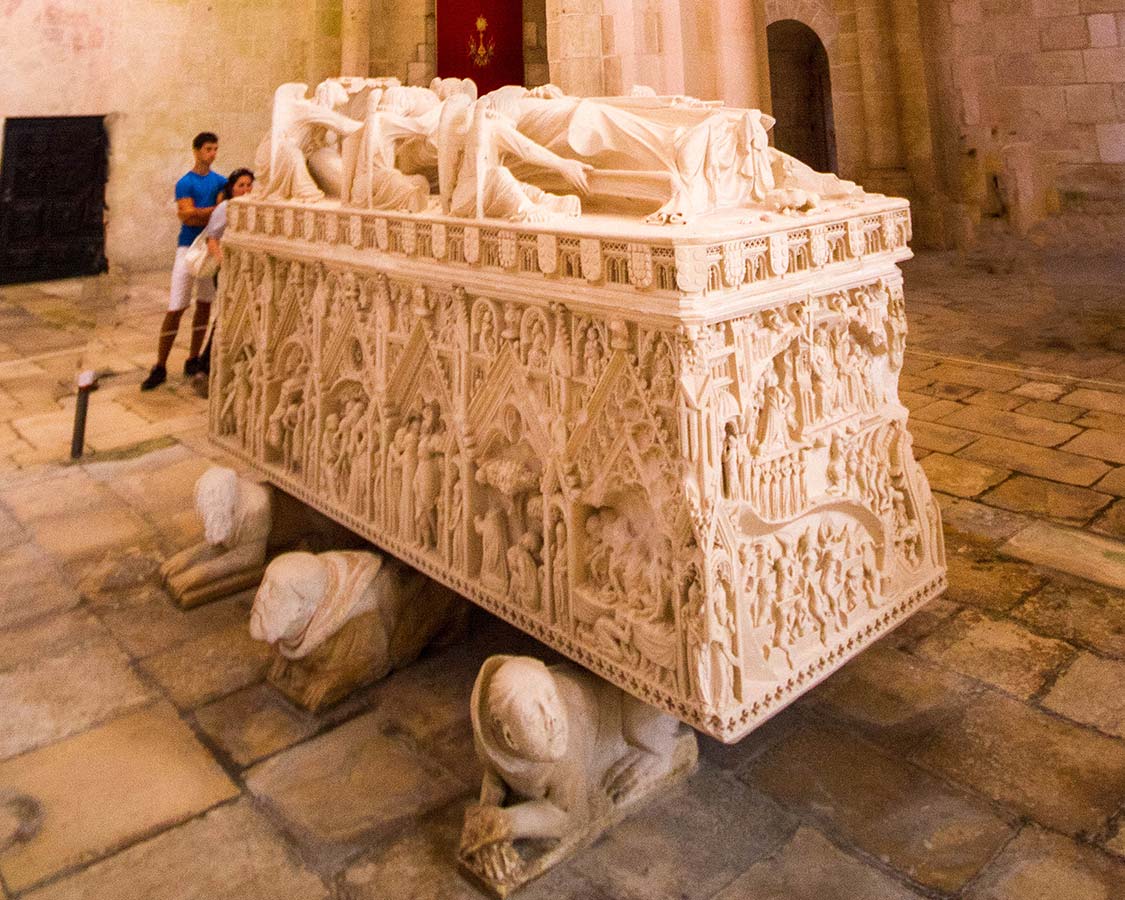
Just two years after her death, Dom Pedro became king of Portugal. One of his first acts was to exhume his dead lover and have her placed in an intricate tomb where everyone could honor her. According to legend, Dom Pedro chose at his time of death for them to be laid in such a way so that when they arose in the afterlife they would see each other.
The tombs were every bit as intricately carved as I had read. I could clearly discern the Last Judgement scene at the foot of Ines’ tomb and the Wheel of Fortune at the head of Dom Pedro’s tomb.
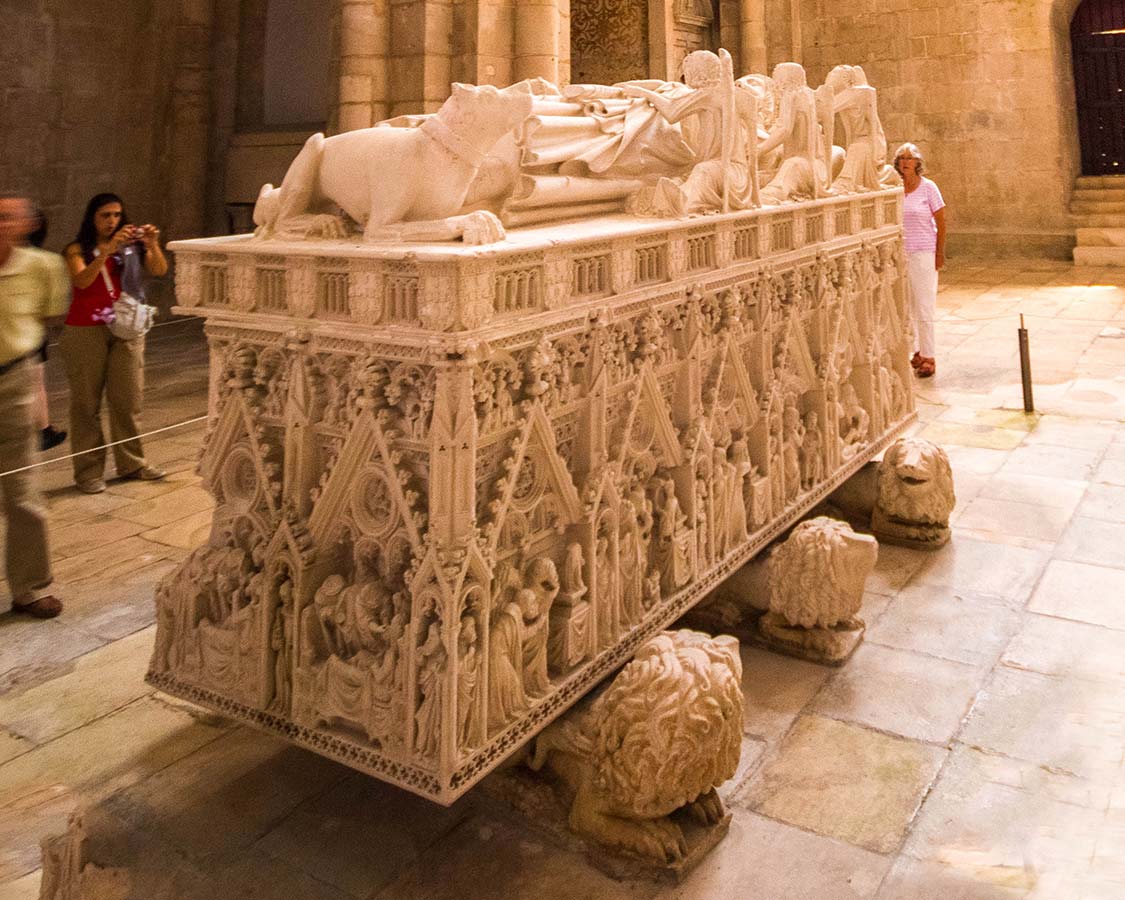
Exploring The Alcobaca Monastery
After paying our respects to Dom Pedro and Ines we wandered to the massive kitchen in the Alcobaca Monastery. It’s hard to imagine the need for such a large kitchen, but at its peak, there were almost 1000 monks in the Monastery! No wonder there were seven dormitories and a library on site. Adjacent to the kitchen is the refectory where the monks of Alcobaca sat in quiet reverence while they ate their meals.
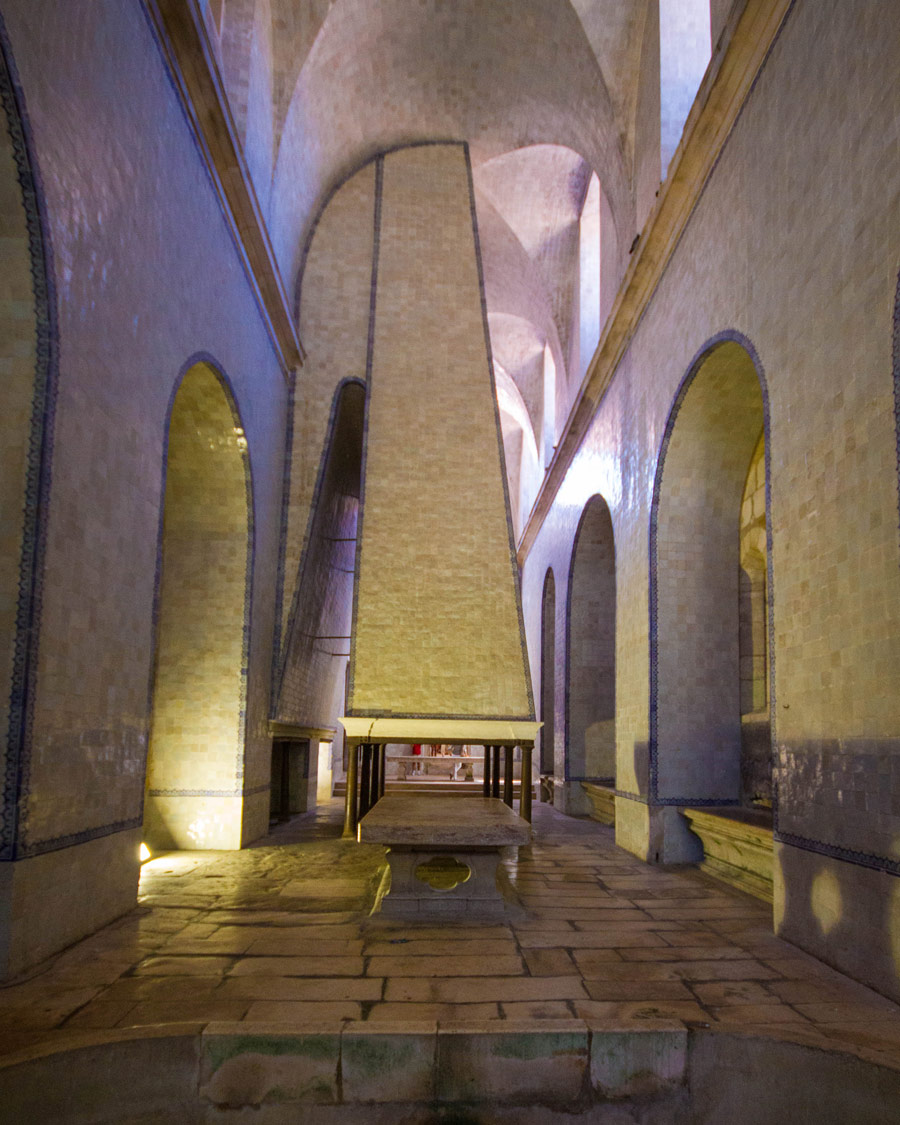
Cloister of Silence (Claustro do Silencio)
Next, we headed to the Cloister of Silence. The two-story cloister was every bit as beautiful in person as I had previously seen in pictures. We walked among the orange trees in the lower level to get a 360° view of the intricate design. From the lower level of the Cloister of Silence, we made our way to the upper level which offers incredible views of the Alcobaca Monastery cloister garden. The Manueline style really stood out as it is quite different from the rest of the Monastery.
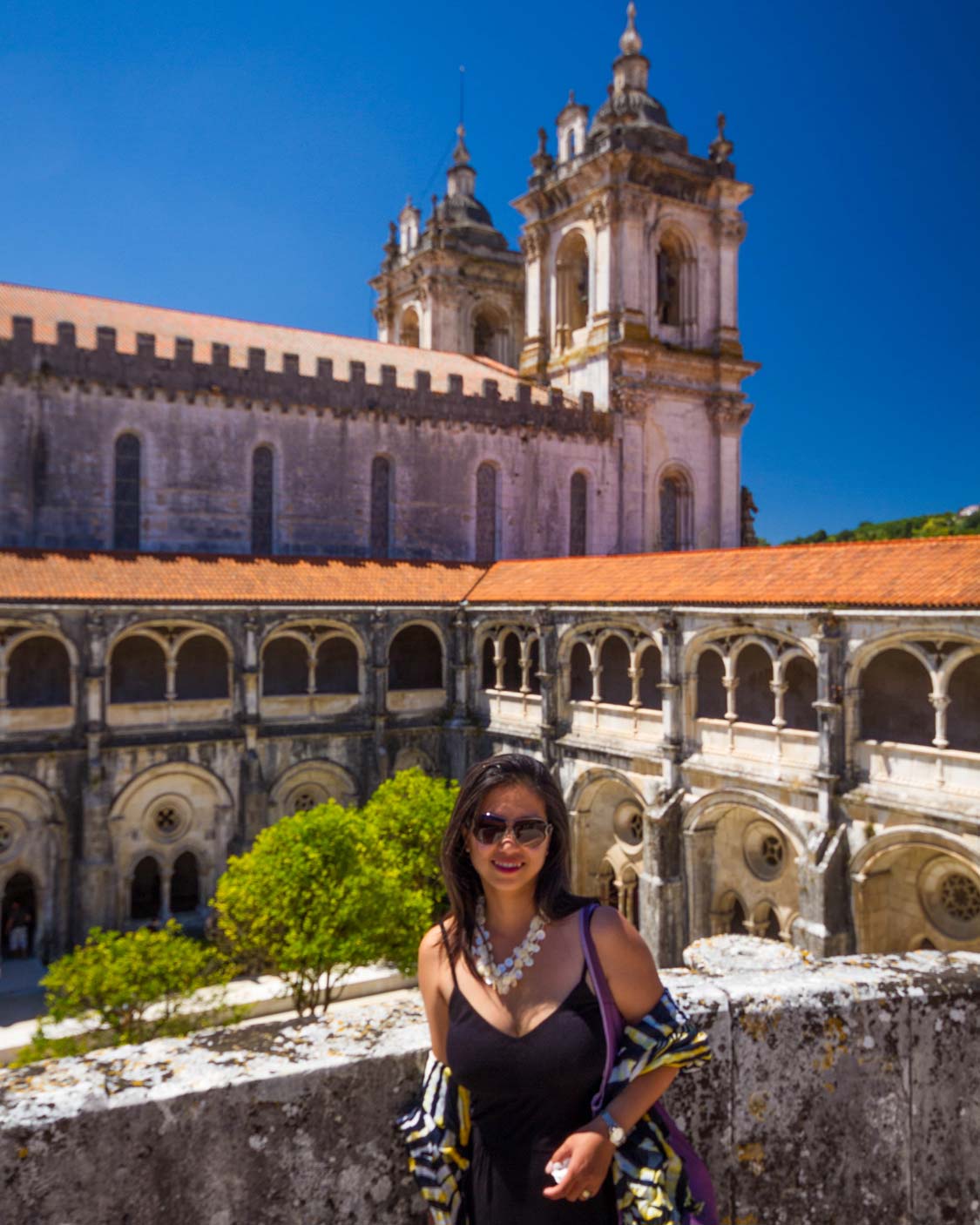
Exploring Batalha Monastery in Batalha Portugal
The second monastery to visit on our list was in the town Batalha, which is only 30 minutes and 24 km (15 miles) from Alcobaca by car. The Batalha Monastery (Monasterio de Santa Maria da Vitoria) has a dramatic and detailed exterior that really stands out amongst the modern architecture of Batalha Portugal. It was the perfect second stop on our tour of Alcobaca, Batalha, and Tomar.
The Batalha Monastery is a Dominican Abbey built beginning in 1386 over more than a hundred years. It was finally completed in 1517 . The monastery has a dramatic Gothic architecture with strong Manueline accents. The building has tremendous architectural value and its historical significance led to the building being classified as a UNESCO world heritage site in 1983.
It’s impossible to miss the Batalha Abbey as you come into town. It towers over the nearby buildings and it’s impressive facade absolutely dominates the surrounding skyline. The spires
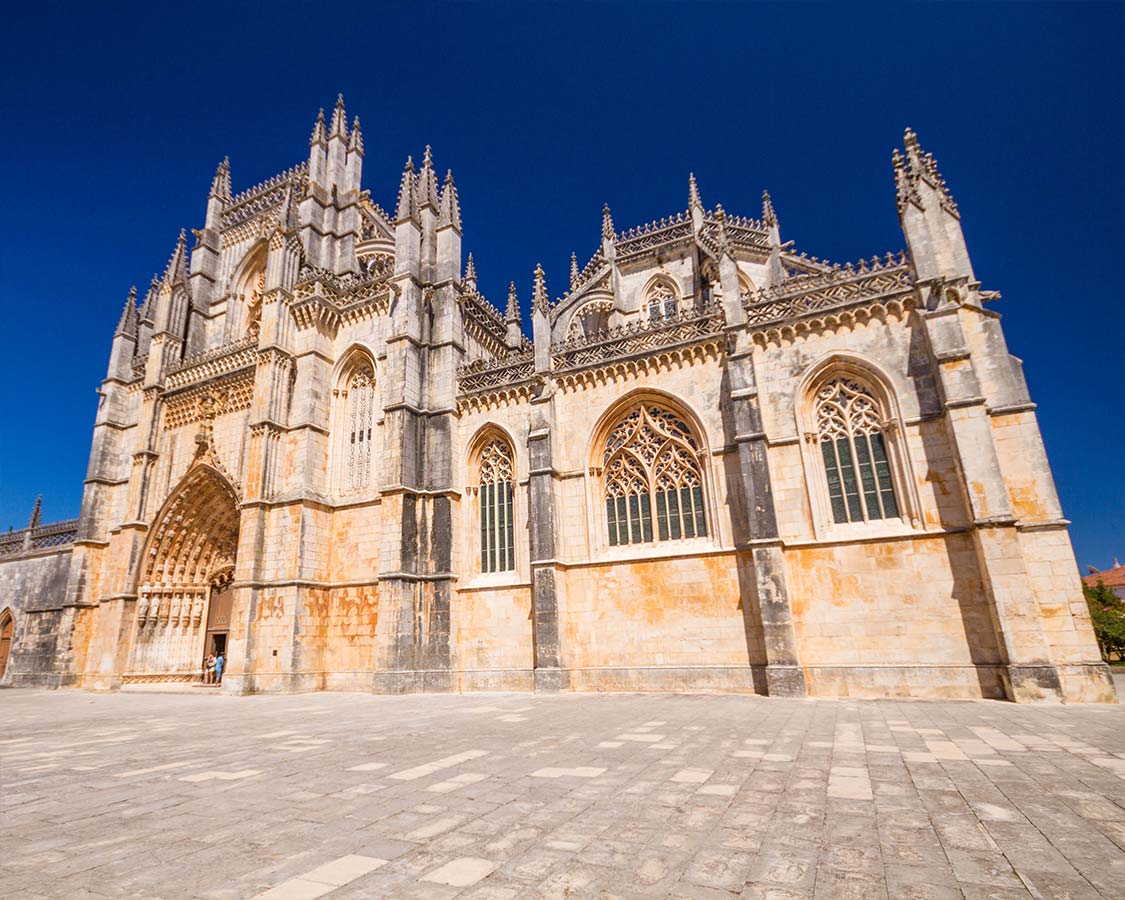
The exterior of Batalha Monastery makes it pretty obvious as to why the church took two centuries to be completed. The limestone building, now in an ochre hue due to the stains of time, has pinnacles, parapets, and flying buttresses. I could have stared at the intricately carved windows and doorway for hours.
Interior of Batalha Monastery
At first glance, the Monastery of Batalha looked very similar to the Monastery of Alcobaca. Both have vast but narrow naves and rather plain interiors dominated by massive Gothic pillars. And because we arrived in the late afternoon, the sun was perfectly shining through the rich stained glass windows. The bright colors of the Batalha Monastery glass gave the church a warm glow we did not see in Alcobaca.
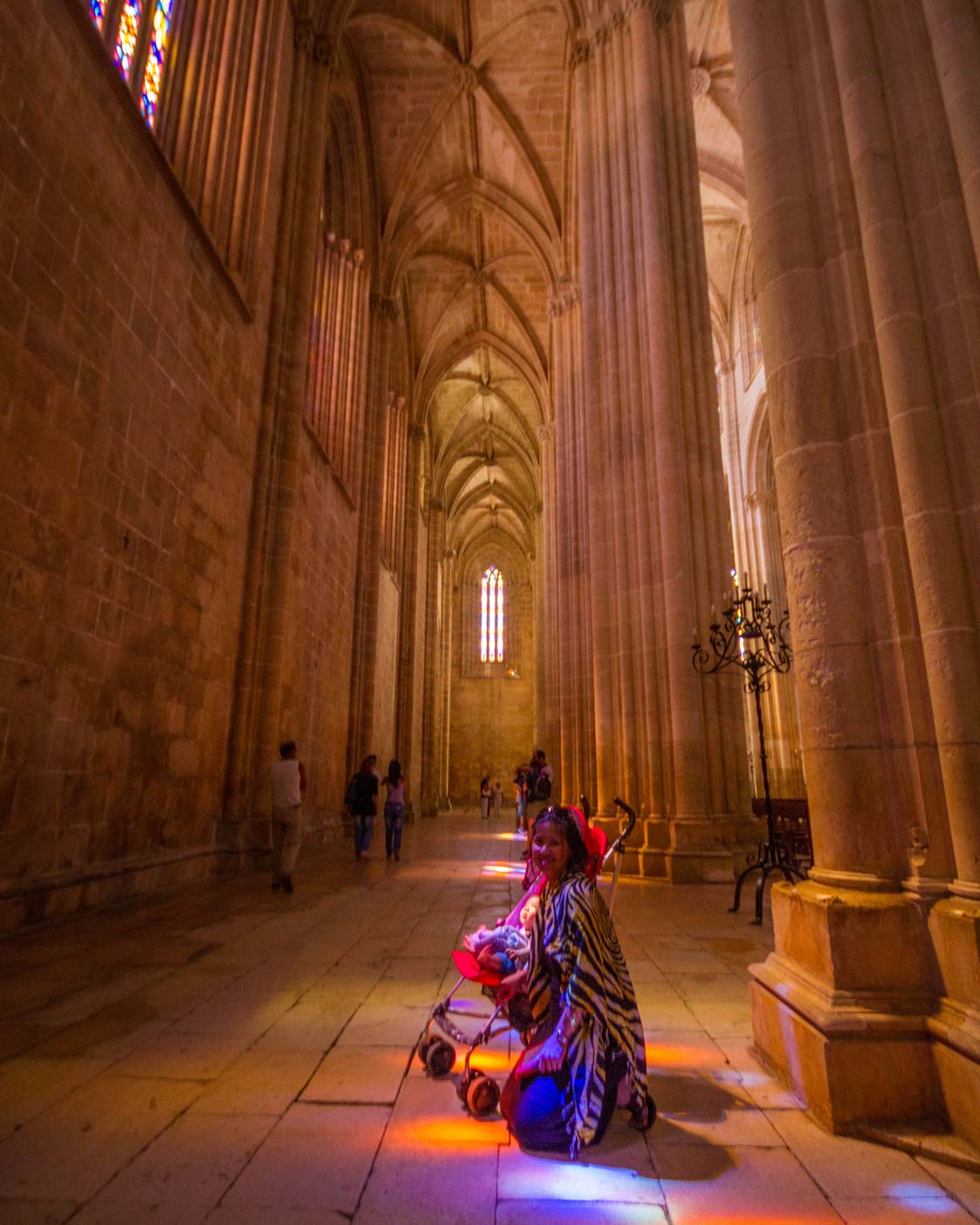
Claustro Real (Royal Pantheon)
The Royal Cloisters or the Royal Pantheon of the Batalha Monastery was one of the most dramatic parts of the complex. The cloister was originally designed in Gothic style by Afonso Domingues in the late 1380s. But the Manueline additions by Diogo de Boitac really gives the Claustro Real the dramatic style that has made it so popular.
And boy, did it ever take our breath away. It was made even more striking when compared to the very plain Claustro de Dom Afonso V which is also on part of the Batalha Monastery.
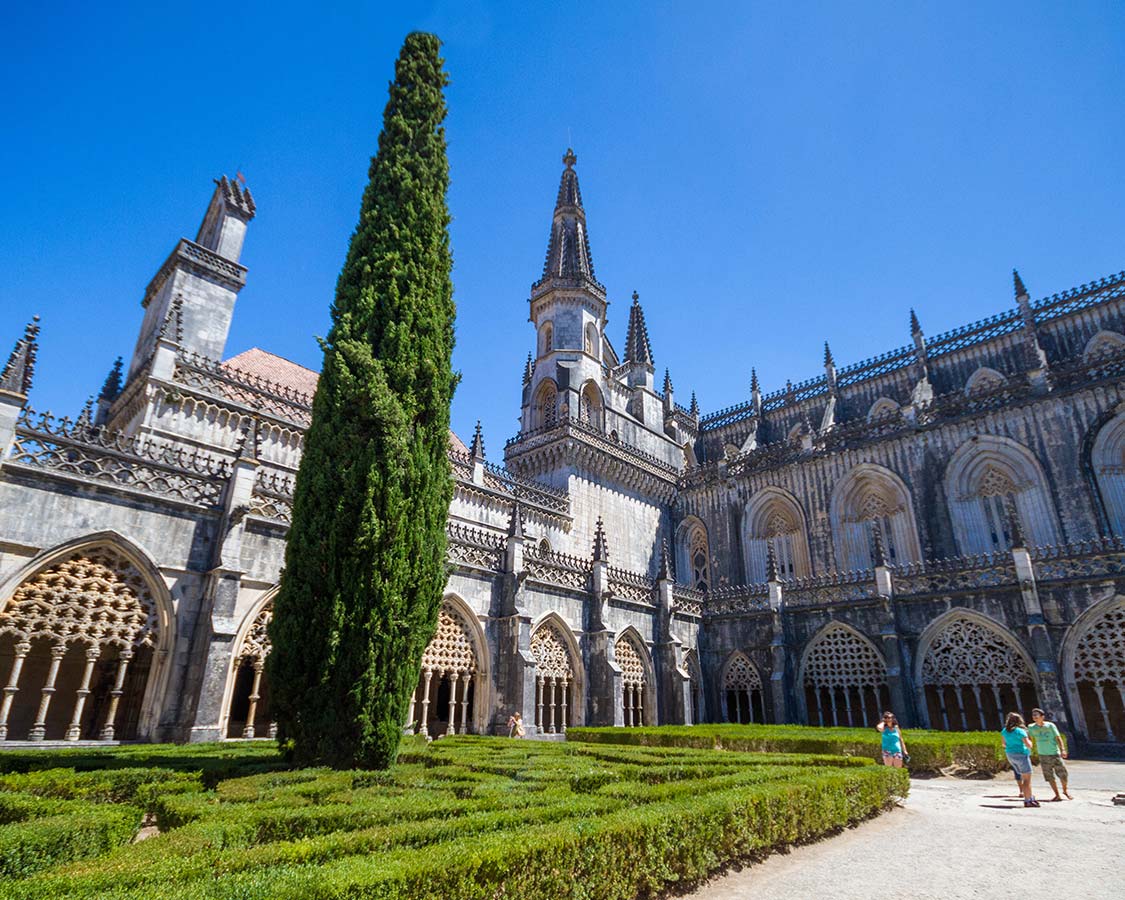
Capelas Imperfeitas (Unfinished Chapels)
One of the most incredible parts of the Batalha Monastery is the open-air unfinished Chapels in the eastern end of the Abbey. The Unfinished Chapel was our last stop within the Monastery of Batalha. To reach this octagonal mausoleum we actually had to exit the Abbey. As with other aspects of this site, it is the Manueline additions, this time by Mateus Fernandes, that truly makes the site extravagant.
There was absolutely no comparison between the unfinished chapels at the Batalha Monastery and the Unfinished church in Bermuda that we visited. The Batalha monastery wins the style awards hands down.
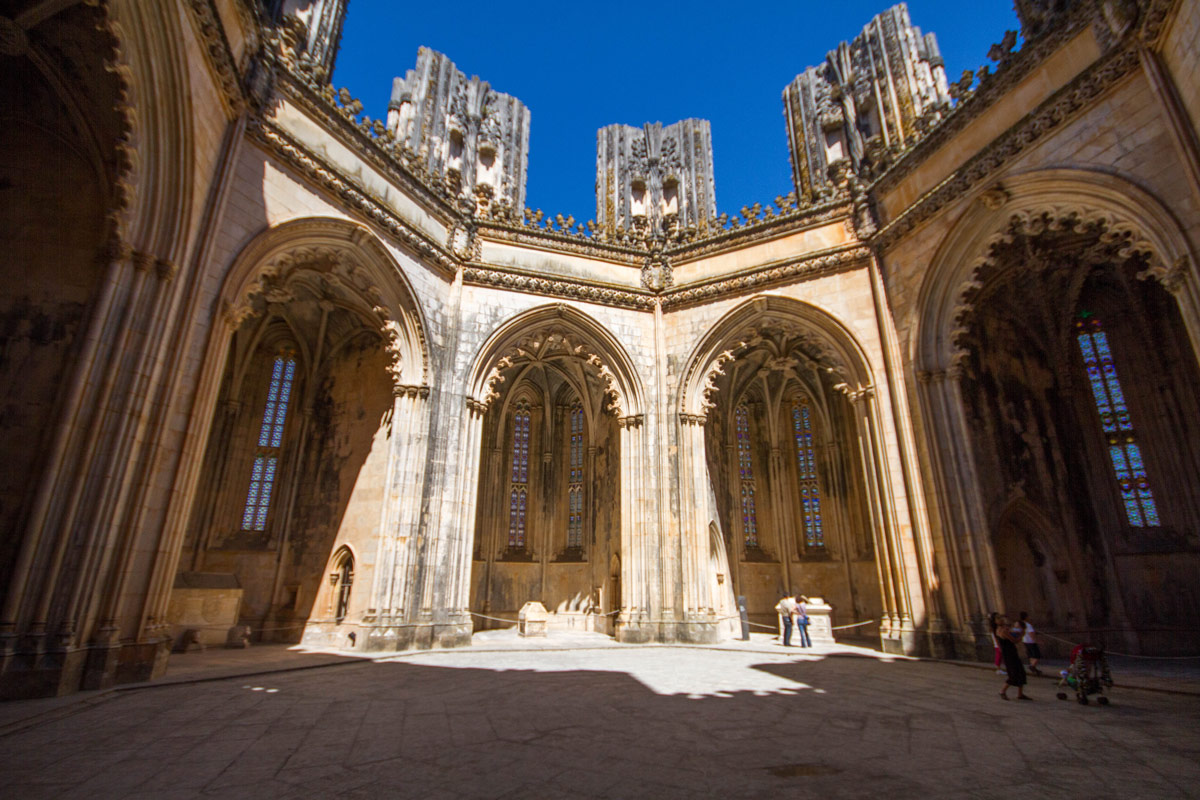
The Convent of Christ in Tomar Portugal (Convento do Cristo)
The third and final monastery on our list was in the town of Tomar Portugal, which is roughly 40 minutes east of Batalha on highway IC9. Placed on the UNESCO World Heritage List in 1983, the Convento do Cristo is impossible to miss when driving into the small city of Tomar. This Knights Templar headquarters is on a hill and rises above its wooded surroundings.
There is no mistaking the difference between Convento do Cristo in Tomar to the Alcobaca and Batalha. It’s the oldest of the three religious sites. The Tomar convent was begun in 1118 and completed in 1160, which compared to Alcobaca and Batalha, is lightning fast. And the position of the Convent of Christ in Tomar as a stronghold for the Knights Templar shows in its rugged appearance.
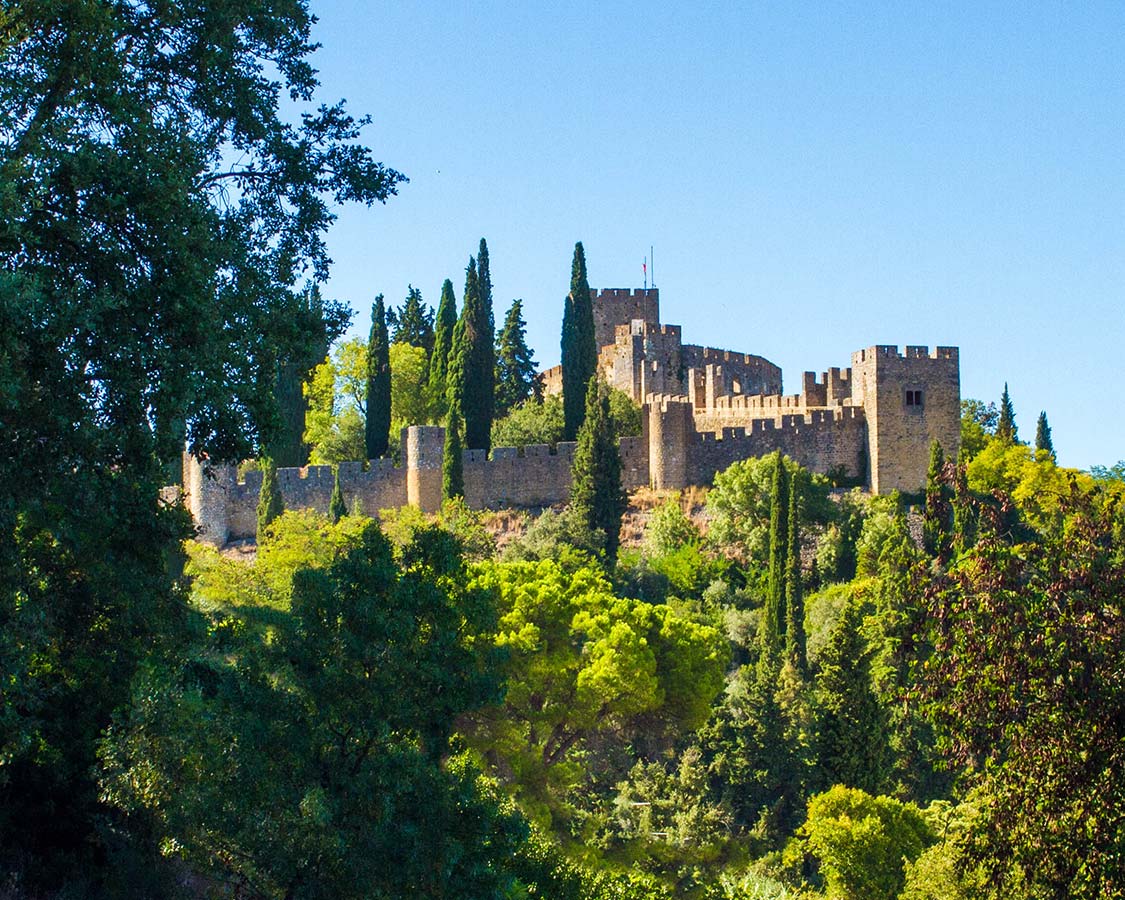
Charola (Rotunda Church) of Convento do Cristo
We started our tour of Tomars Convent of Christ at the Charola. The 16-sided Knights Templar church is sometimes called the Rotunda. Inside was an octagonal altar similar in design to the Holy Sepulchre altar in Jerusalem. Legend has it that the church was circular in design to enable the Knights to attend church while still on horseback. Whatever the reason, it remains one of the most striking altars I have ever seen. It was very ornate with paintings, frescoes, and gilded accents.
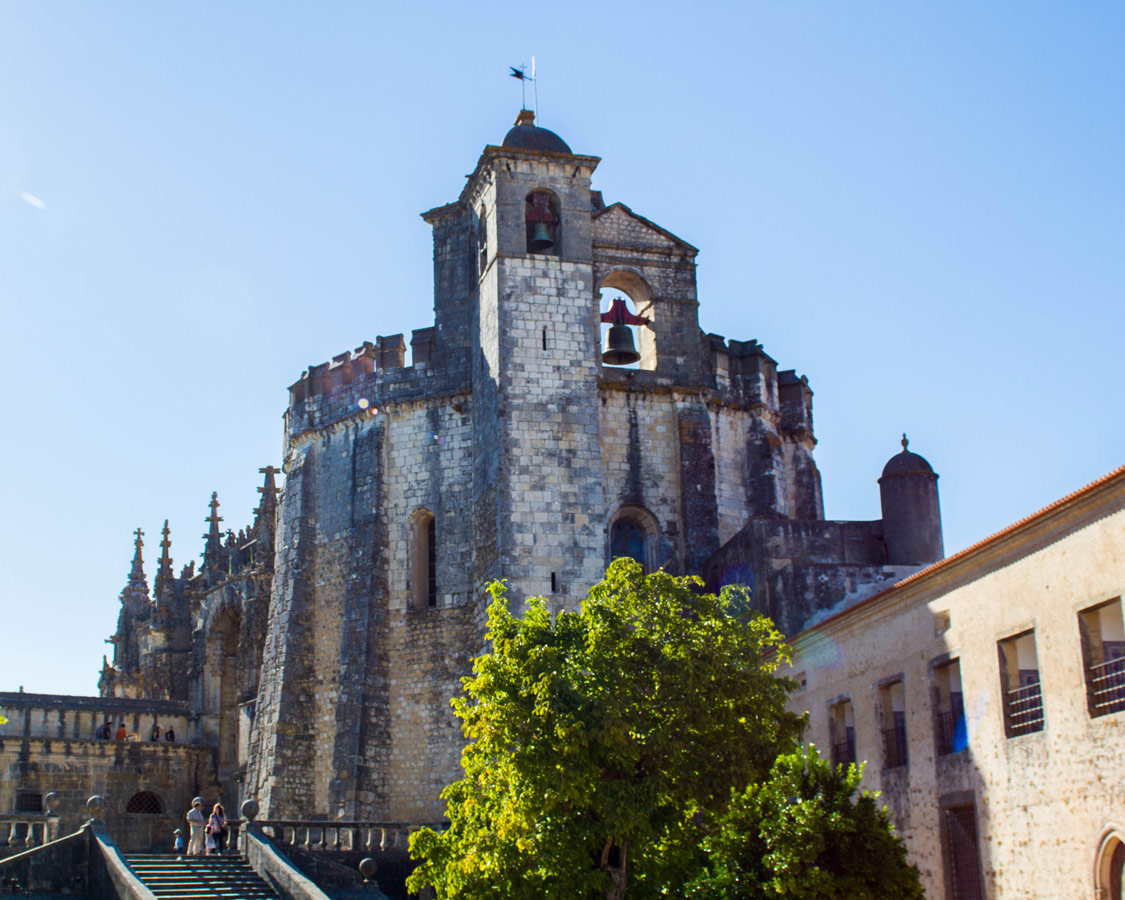
Manueline Church
Connected to the Charola by an archway is the Manueline Church of the Convent of Christ in Portugal. The Manueline church has two levels. And while the outside walls of the convent of Tomar are bleak and rugged, the Manueline Church is beautiful and ornate. A striking feature is the ornate ribbed vaulting on the ceiling in the upper choir. However, the most popular feature of the church is a detailed window found on the exterior better known as The Manueline window.
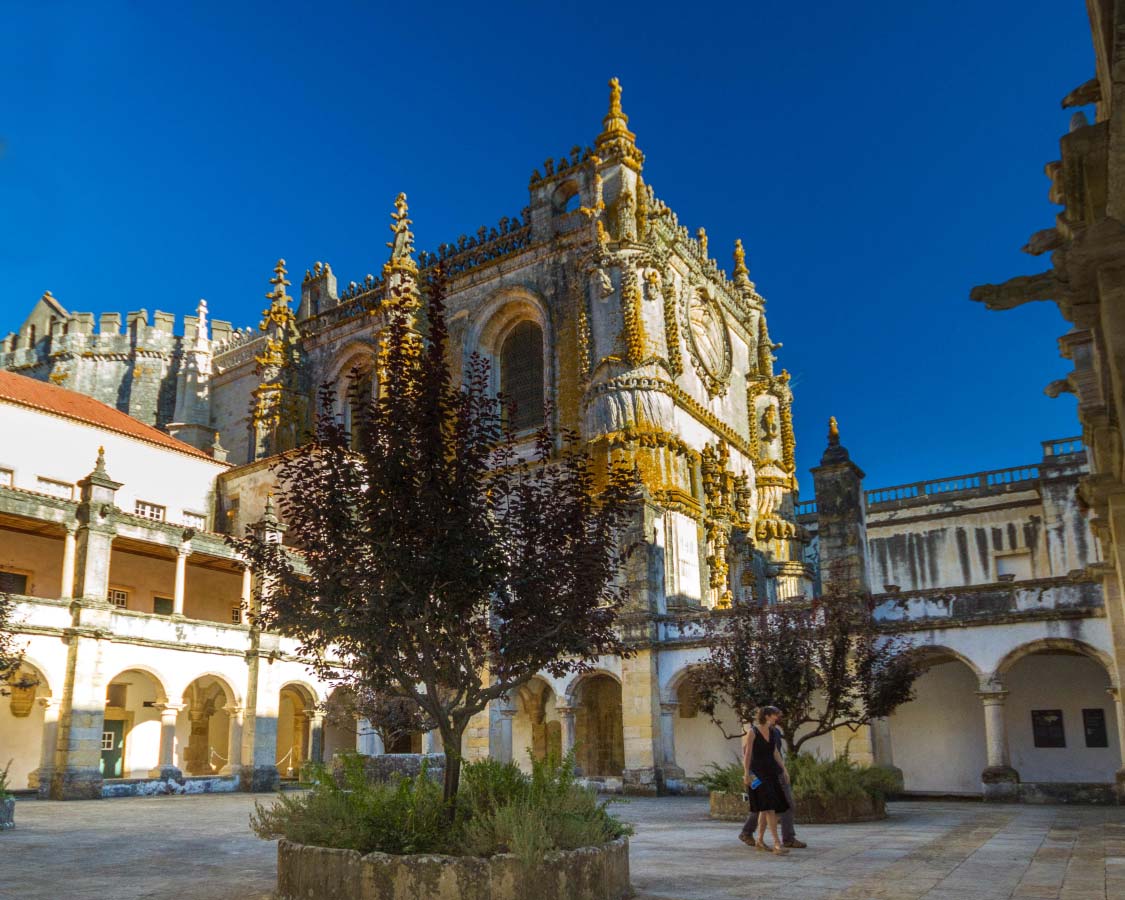
The Great Cloister of the Tomar Monasteries
From the church, we explored the many cloisters within the monastery. The Convento do Cristo has 8 cloisters. The most picturesque of the Tomar monasteries is the Great Cloister. The Great Cloister of Tomar has concealed spiral staircases that can be found in the corners leading to the Terrace of Wax.
The terrace, which runs along the upper levels, was so named as it is where honeycombs were left to dry. Some of the other most notable cloisters in the Tomar monastery were the Cloister of the Crows, Bread Cloister, Cemetery Cloister, and The Washing Cloister.
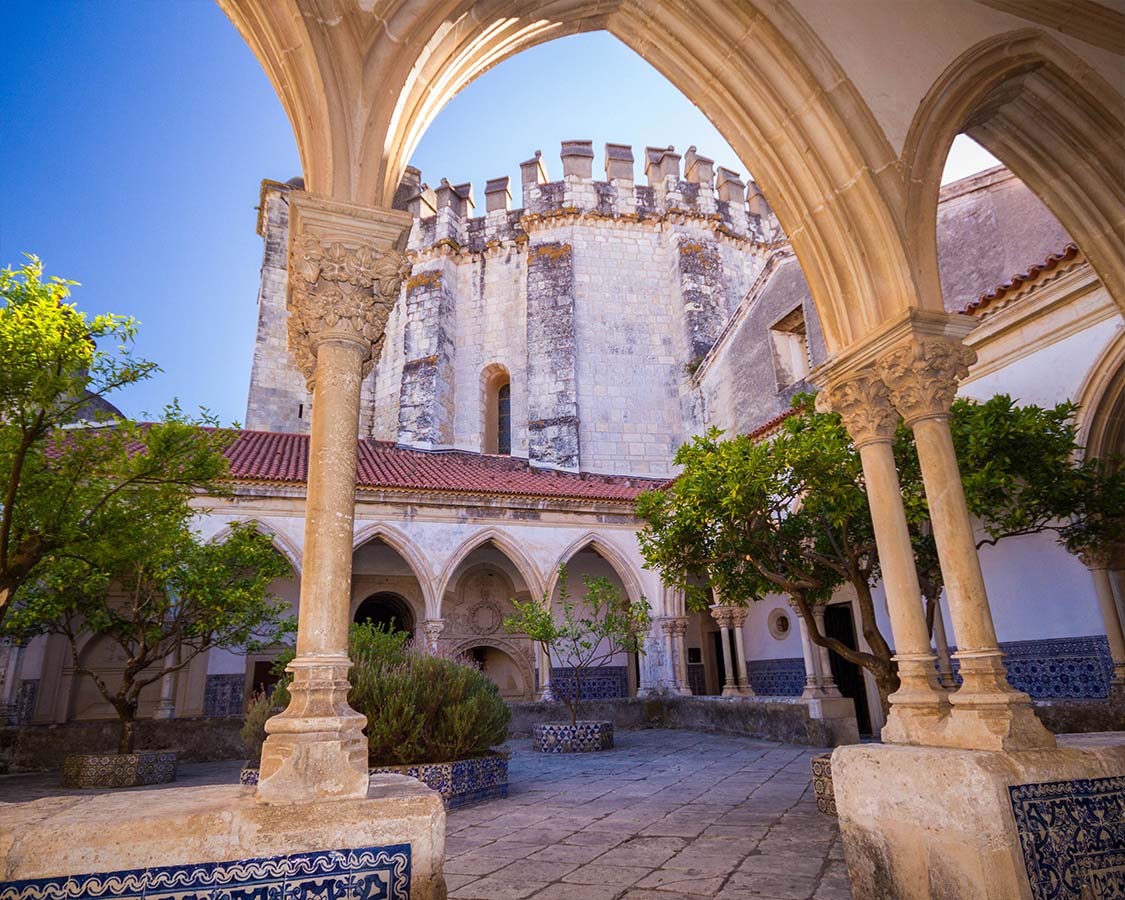
Tomar Portugal Knights Templar Castle
At the end of our self-guided tour of Alcobaca, Batalha, and Tomar, we visited the Knights Templar Castle in Portugal. Built in 1160, the former royal quarters now lay in ruins. But, the castle keep is still very much intact.
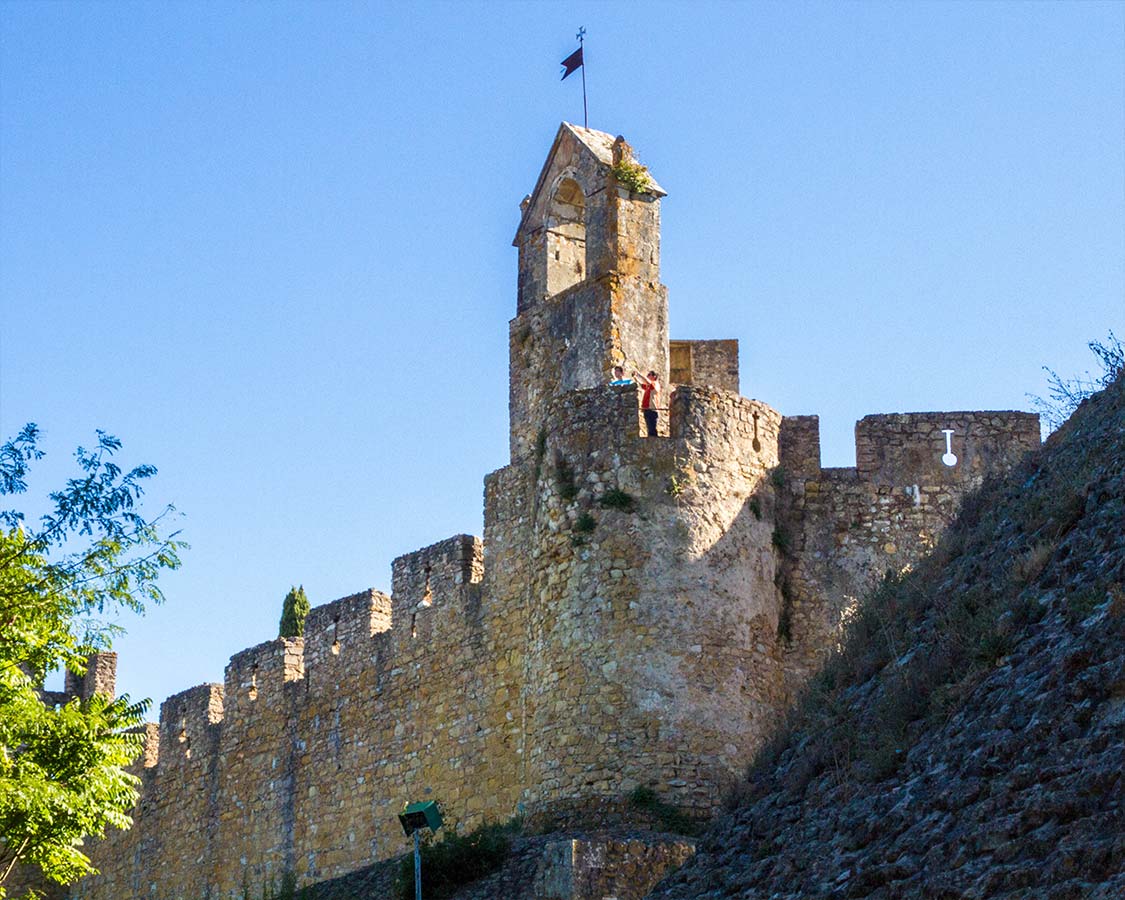
Tips for Visiting the Monasteries of Alcobaca, Batalha and Tomar
For interesting day trips from Lisbon definitely consider visiting the towns of Alcobaca, Batalha, and Tomar to experience 3 architecturally inspiring sites. Although it is possible to visit all three sites in one day, we don’t suggest it. Instead, pick two sites and leave the third site for the next day. You can also expand your tour of Portugal’s heartland by also visiting the miraculous area around Fatima and Obidos and the prehistoric fields of dinosaur footprints in Ourem.
But our biggest tip for exploring Alcobaca, Batalha, and Tomar is to look around. Explore these incredible places because they all have surprises hidden in areas you might never suspect. Look under stairs and around corners to see what amazing secrets the monasteries of Portugal have in store. And don’t forget to look up too. The ceilings in the Portuguese monasteries are incredible!
A Bonus Castle Near Lisbon Castelo de Almoural
After we visited Tomar monastery we began our drive back to Lisbon. Soon, the GPS prompted us to a castle that was nearby (Many GPS’ have a feature that indicates when points of interest are nearby, and we are always checking what they are). After visiting the incredible castles of Sintra, we definitely wanted to see more of Portugal’s castles. So, we stopped to visit the Castelo de Almourol.
The castle is on an island and unfortunately, the last boat to Castle de Almoural had just made its last run for the day. But, the views from the shore as Castle de Almoural was lit by the late-day sun made the stop more than worthwhile.
We later found out that the castle truly ancient. It was originally built in the 1st century BC. While the exact origin of Castle de Almoural is uncertain, it has evidence of Romans, Knights Templar, and medieval influences. We were so glad to have stopped by. What a great way to end our day. What are your favorite sites in Portugal?
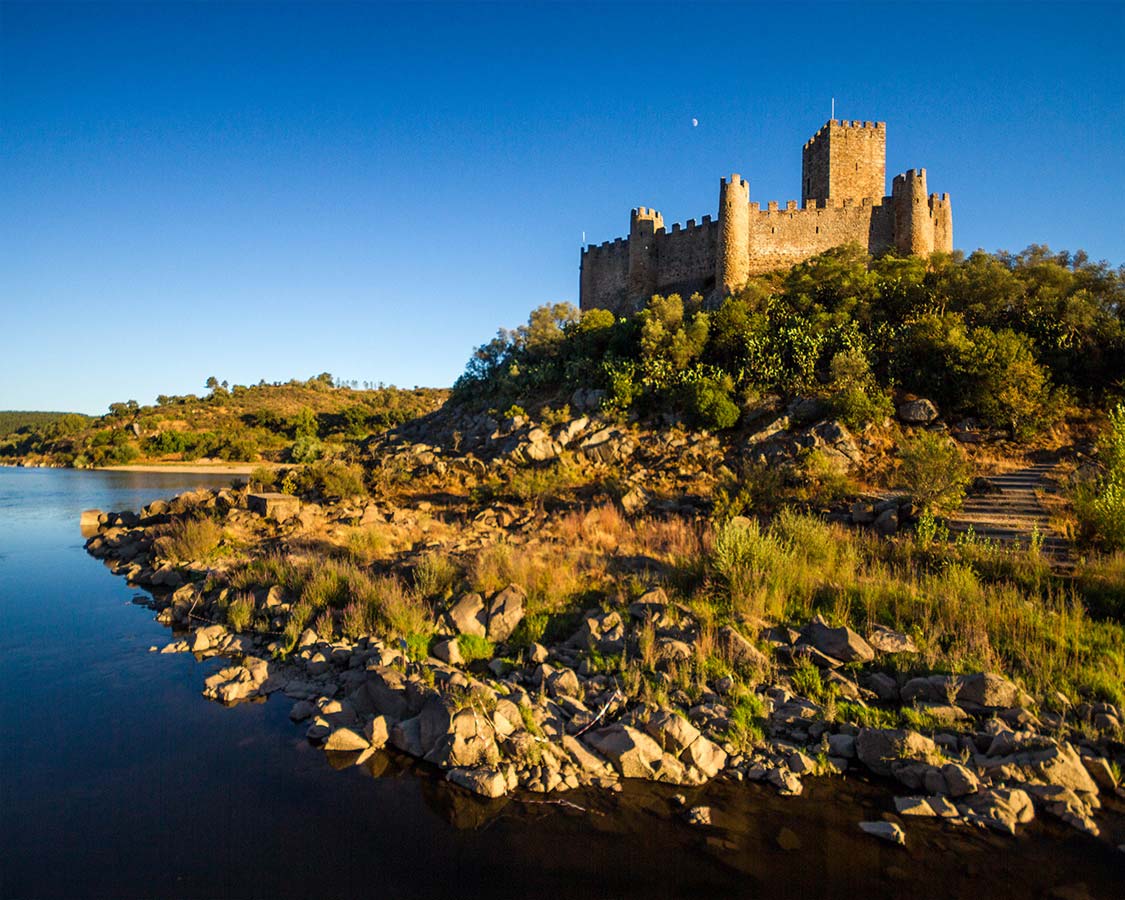
How Much Does It Cost To Visit Alcobaca, Batalha and Tomar
The Alcobaca, Batalha, and Tomar religious are each separate attractions in Portugal. There is a €6 entrance fee for adults. Children 12 and under are free. You can also purchase a Heritage Trail pass is valid for 7 days and includes entrance to each of the three religious sites. The Heritage Trail pass is €15.
There was no parking fee’s in either Alcobaca, Batalha, and Tomar, so visiting the three sites by car was very practical. However, if you don’t have access to a car, there are tours that start in Lisbon and visit Alcobaca, Batalha, and Tomar. These tours often include a visit to the Portuguese pilgrimage site Fatima as well.
Have you explored the Monasteries of Portugal’s Heartland? If you’ve visited Alcobaca, Batalha, or Tomar, tell us about your experience in the comments. Or swing by our Facebook page and post a photo. We would love to share in your adventure!
Visiting The Monasteries Of Portugal With Kids
Visiting the Monasteries of Portugal with Kids is amazing. There are so many areas of these historic buildings to explore that it’s easy to make exploring them a game. Kids will love all the hidden stairs and passageways. If you are visiting Portugal with a baby as we were, most places are stroller friendly. Although, if you want to take in the upper levels, it’s good to be aware that there are no ramps. We found using a child-carrier to be helpful in many of the cities and Portuguese monasteries.
Wandering Wagars is a participant in the Amazon Services LLC Associates Program, an affiliate advertising program designed to provide a means for sites to earn advertising fees by advertising and linking to amazon.com, amazon.co.uk, amazon.ca. Amazon and the Amazon logo are trademarks of Amazon.com, Inc. or its affiliates.
You May Also Like To Read:
Pin This Post For Later:
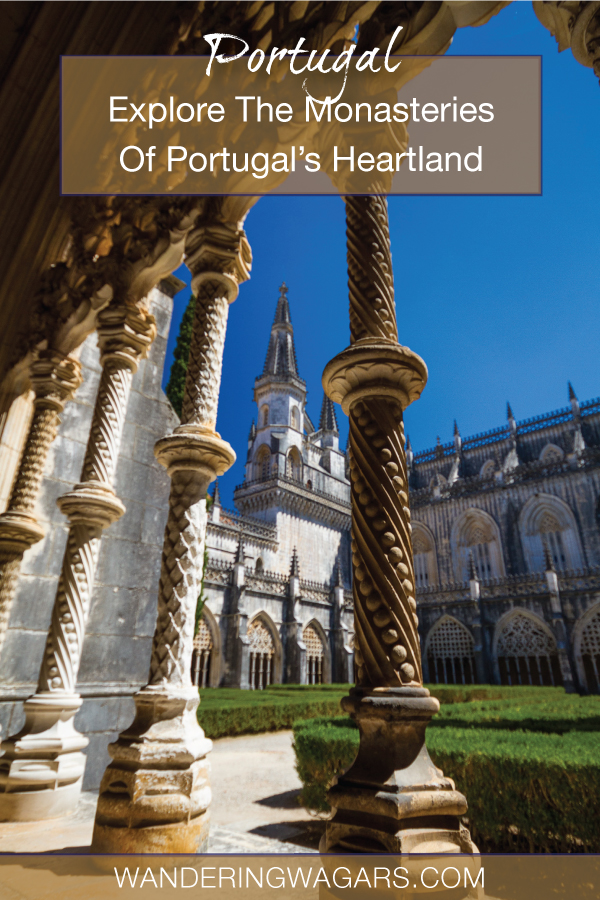

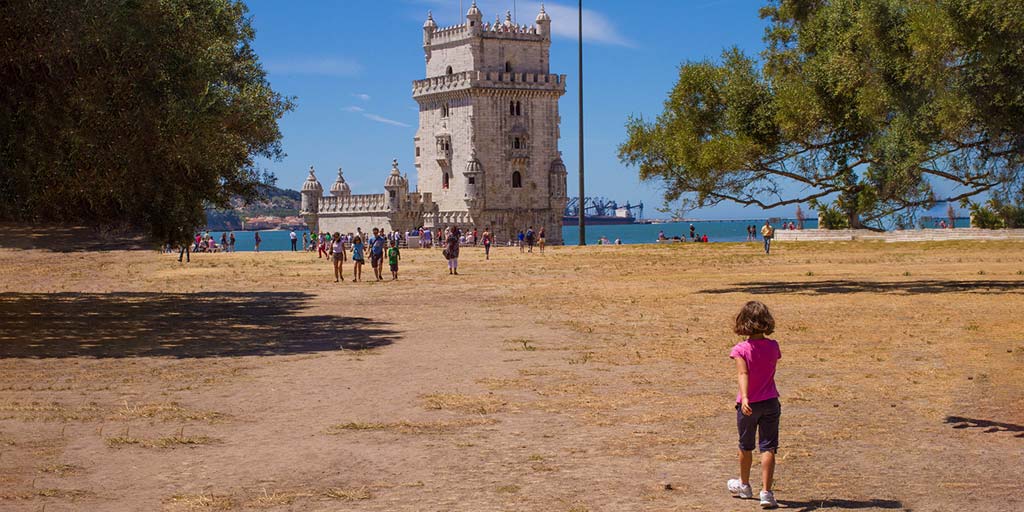
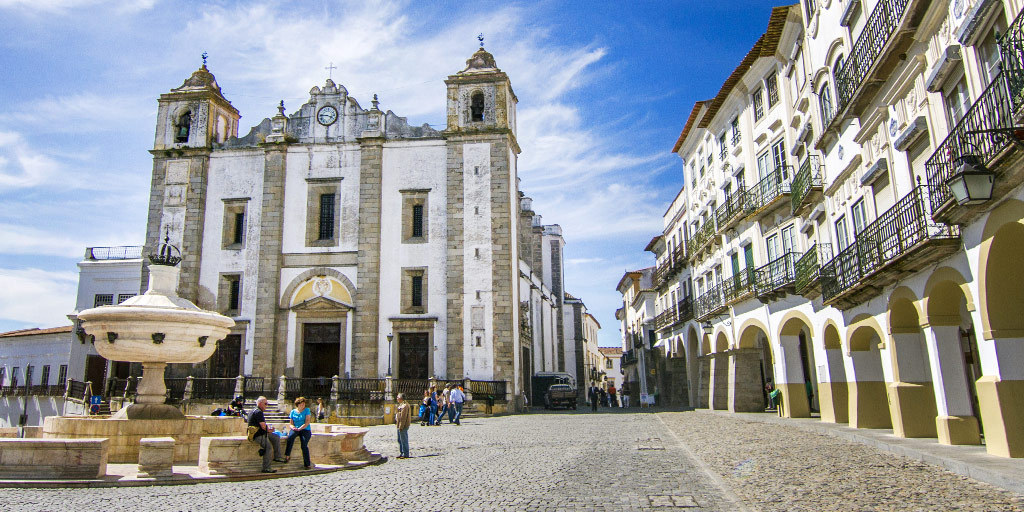
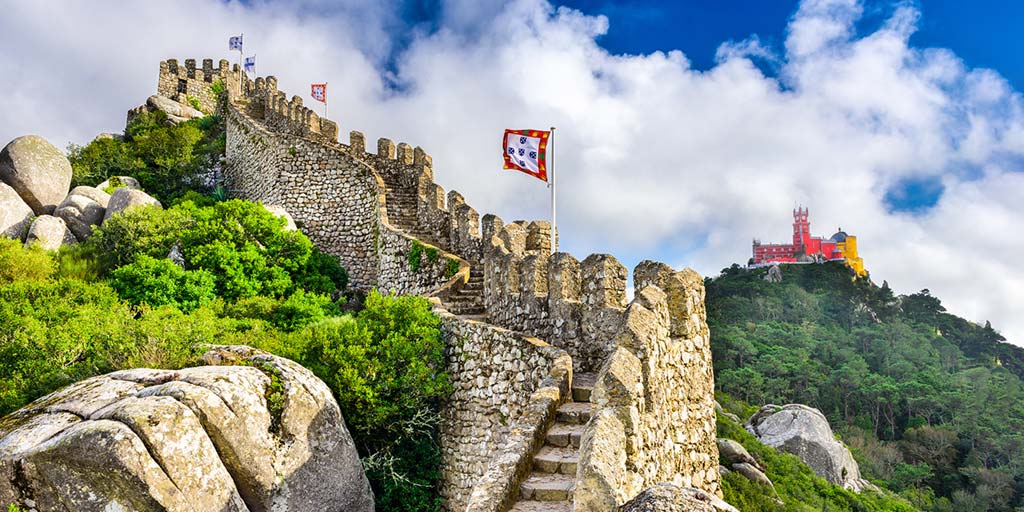
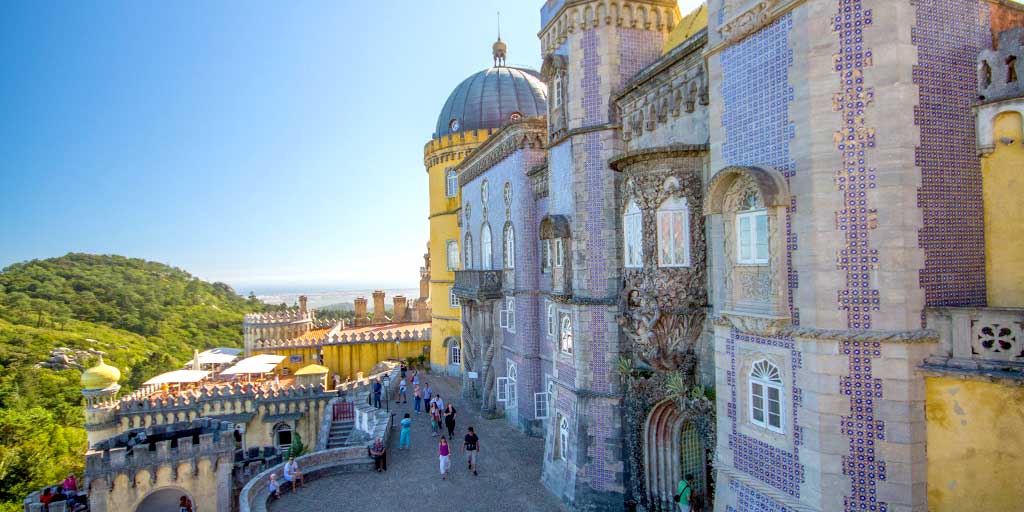
Victoria
Sunday 7th of April 2019
Thank you for that. Portugal is our favorite place to visit now. It’s hard to try to see as much when we only travel about a week at a time because of work. Now I’m undecided. Lol. Love your pictures and posts! Keep it coming! PS. Wish we were as brave as you guys when the kids were young. We totally forgot about our bucket lists and just got started fairly recently. We did family travel but not as adventurous as you guys. So awesome!
Victoria
Sunday 7th of April 2019
Awesome visits! We did a Viator day trip to Batalha and Alcobaca, Cascais and Sintra and stayed in Fatima but I don’t think we saw all the things you showed here for these two monastery towns. I gather that you are self guided. How do you do it?! We are going back to Lisbon in June and I am planning our itinerary, looking at Evora - how I came upon your blog. Was planning to go to Porto and do the towns along the way but now I’m thinking to forego Porto and north.
Kevin Wagar
Sunday 7th of April 2019
Hi Victoria! Thank you so much for the kind words. We did do a self-guided tour. It was our first trip with our 4-month old son and we thought that having a car for feeding and naps would be beneficial. We were right. It also gave us the ability to explore at our own pace and move off-the-beaten-path a bit. I'll be totally honest, I wish we had had the chance to visit Porto. We're looking for a chance to go back and see what we missed.
Mimi and Mitch
Wednesday 26th of April 2017
We had absolutely no idea that Portugal had those kind of churches and buildings. I can see how people would spend hours and travel all over the land visiting them! To see castles where the Knights Templar were known to be must have been such a cool experience.
Hilarye
Tuesday 25th of April 2017
Gorgeous photos!
Reshma Narasing
Tuesday 25th of April 2017
Wow, all the three monuments look so stunning. I was saddened by the tragedy of Dom Pedro and Ines - their domes look so magnificent. Had never such intricately carved domes before, even in pictures! Thanks for sharing these brilliant architectural sites of Portugal.